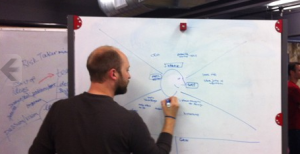
The American educational system teaches science, but it doesn’t support entrepreneurship, said Leticia Britos Cavagnaro, associate director of Stanford University’s Epicenter. “We want to unleash the entrepreneurial potential of engineering students across the U.S. so they can become bold innovators.”
Stanford’s Hassno Plattner Institute of Design partnered with Epicenter, an initiative that aims to tap undergraduate engineering students’ entrepreneurial potential, to hold a hands-on workshop Friday that tasked participants to put “design thinking” to use to solve the problem.
The challenge? To integrate entrepreneurship and innovation into the college engineering experience.
“Can we think of a different kind of education, one that is about coming together, from across disciplines, and solving the complex problems of the world?” Cavagnaro asked roughly 30 event participants?
The workshop followed the “design thinking” template: empathize, define, ideate, prototype and test.
1. Empathize
Unpack assumptions about the topic of the challenge. “You need to be curious and care about their story,” Cavagnaro said.
One team interviewed 20-year-old Ohlone College engineering student Francisco Ramirez about the design process he uses when planning a project.
“I really look up to Steve Jobs,” Ramirez said. “He knew how to design and create things that people are going to use, that change how we live — I want to do that.”
2. Define
“You need to make meaning out of those notes, all that data you have,” Cavagnaro said.
“A freshman engineering student needs a way to build his identity as an entrepreneur because he wants to have a positive impact on others,” one team concluded based on its conversation with Ramirez.
3. Ideate
“In this phase you’ll want to generate lots of ideas, and separate the generation of ideas from the evaluation of ideas,” Cavagnaro said. “Be a divergent thinker.”
4. Prototype
“Prototyping is a way to make ideas tangible and test them, Cavagnaro said. “It has a lot to do with failure. If you’re not failing very often, you’re probably not pushing yourself.”
One team created a mock video a student could watch to get a sense of the sorts of problems a CEO might face.
“It gives the user a sense of the CEO identity,” computer scientist Prahlada Varadan Thirumala said. “He can try out different roles.”
5. Test
Cavagnaro urged participants to listen to user feedback when testing a prototype.
“Don’t worry about whether what your user suggests is possible,” Cavagnaro said. “You want to know why they want something changed. Let the user do all the talking — you listen and ask questions.”
[cincopa AsKAp1KOwl61]
Stanford Entrepreneurship Week 2012 takes place February 27 through March 7. This collection of over 30 events is hosted by the Stanford Entrepreneurship Network (SEN), a federation of programs, student groups and organizations supporting entrepreneurship in the Stanford community. For a complete listing of events check: https://sen.stanford.edu/e-week/calendardu/e-week/calendar
